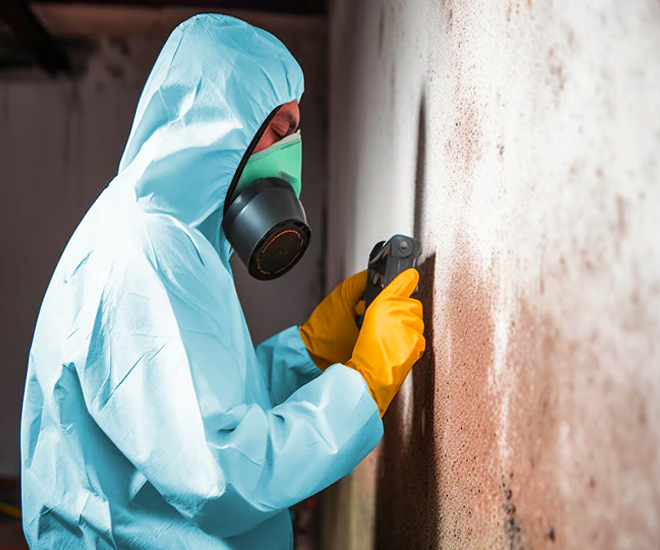Testing Air Quality After Mold Remediation
Testing Air Quality After Mold Remediation
Blog Article
Expert Tips for Article Mold Removal Success
In the realm of mold and mildew remediation, efficiently eradicating mold and mildew is just half the fight; the real difficulty lies in stopping its reappearance. By adhering to experienced tips and best methods, people can guard their spaces against mold revival and maintain a healthy and balanced indoor atmosphere.
Screen Moisture Degrees Regularly
After finishing mold and mildew remediation procedures, preserving ideal moisture degrees is essential to stop mold and mildew re-growth and ensure a healthy and balanced indoor setting. High humidity levels over 60% develop a helpful atmosphere for mold and mildew to grow, making regular keeping an eye on an aggressive procedure to protect against any type of future mold and mildew issues.
Furthermore, establishing a routine timetable for moisture checks, particularly in risky locations such as cooking areas, cellars, and washrooms, is a positive approach to mold prevention. By continually keeping track of humidity levels, property owners can efficiently minimize the threat of mold and mildew reoccurrence and keep a healthy and balanced interior setting post-remediation.
Conduct Thorough Inspections Post-Remediation
Following the conclusion of mold and mildew remediation procedures, it is essential to perform thorough assessments to verify the efficiency of the remediation procedure. These post-remediation examinations are essential in making sure that the mold and mildew issue has been efficiently resolved and that there is no recurrence or staying mold growth. Inspections ought to be brought out by certified experts who have knowledge in determining mold and examining indoor air quality.
During these evaluations, numerous techniques such as aesthetic analyses, air sampling, and surface area tasting might be employed to extensively assess the remediated areas. Aesthetic evaluations include an in-depth inspection of the premises to check for any type of noticeable indications of mold development or water damage. Air tasting helps in establishing the air-borne mold and mildew spore levels, while surface tasting can find mold particles on surface areas.
Implement Correct Ventilation Approaches
After making sure the efficiency of the mold remediation procedure through complete evaluations, the following crucial action is to focus on implementing proper ventilation methods. Appropriate ventilation is essential in avoiding mold and mildew reoccurrence by regulating moisture degrees and promoting air blood circulation.
Appropriate air flow not just help in stopping mold and mildew growth however additionally contributes to the general health and comfort of look at more info owners. By guaranteeing ample ventilation throughout the home, you can minimize the danger of mold regrowth and develop a much healthier living setting.

Usage Mold-Resistant Products for Repair Works
To improve the long-term effectiveness of mold and mildew remediation initiatives, including mold-resistant products for fixings is crucial in minimizing the danger of future mold development. Mold-resistant products are created to endure moisture and hinder mold growth, making them an important selection for locations susceptible to moisture and humidity. When fixing areas influenced by mold and mildew, making use of materials such as mold-resistant drywall, mold-resistant paints, and mold-resistant caulking can assist prevent mold and mildew reappearance.
Mold-resistant drywall is a superb choice to traditional drywall in areas like restrooms and basements where wetness degrees are greater. This type of drywall has a special finishing that stands up to mold and mildew development even when exposed to damp problems. click to read more In addition, utilizing mold-resistant paints consisting of antimicrobial representatives can even more hinder mold development on walls and ceilings.
In locations where wetness prevails, such as kitchens and washrooms, using mold-resistant caulking around sinks, bathtubs, and windows can assist seal out water and avoid mold and mildew from taking hold in fractures and holes. By spending in these mold-resistant products during repair services post-remediation, you can substantially lower the chance of future mold and mildew concerns and maintain a healthier indoor setting.
Maintain Tidiness and Address Water Issues
After mold and mildew remediation, it is important to maintain a clean environment to stop the regrowth of mold. Leakages, water invasion, or high moisture levels can develop the ideal breeding ground for mold, so it is critical to fix any water-related troubles instantly.
To maintain tidiness, consider making use of HEPA filters in vacuums and air purifiers to trap mold and mildew spores and avoid their circulation in the air. Making certain correct ventilation in areas vulnerable to moisture buildup, such as kitchen areas and washrooms, can aid keep humidity levels in check. By remaining watchful about tidiness and dealing with water concerns promptly, you can efficiently prevent mold page reinfestation and maintain a healthy interior atmosphere.
Conclusion

In the realm of mold and mildew removal, successfully removing mold and mildew is just half the fight; the true difficulty exists in preventing its reappearance. After completing mold and mildew removal procedures, maintaining optimum humidity levels is crucial to prevent mold re-growth and guarantee a healthy interior environment. High humidity degrees above 60% create a helpful setting for mold to grow, making normal monitoring a proactive measure to protect against any kind of future mold issues.
To boost the lasting performance of mold and mildew removal initiatives, integrating mold-resistant materials for fixings is crucial in alleviating the risk of future mold and mildew growth. After mold and mildew removal, it is critical to preserve a clean environment to avoid the regrowth of mold.
Report this page